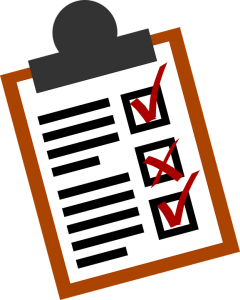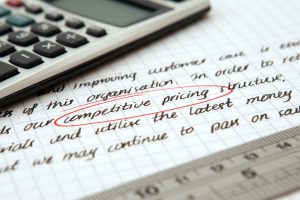What is ‘Return on Investment?’
 Still trying to wrap your head around the concept of return on investment? Whether you are a professional accountant or business owner (or both), this is a term that you’ll probably hear quite frequently during your day-to-day operations. So, what exactly is return on investment? And how does is it used in accounting? To learn more about return on investment, keep reading.
Still trying to wrap your head around the concept of return on investment? Whether you are a professional accountant or business owner (or both), this is a term that you’ll probably hear quite frequently during your day-to-day operations. So, what exactly is return on investment? And how does is it used in accounting? To learn more about return on investment, keep reading.
Return on investment can best be described as the profits generated from one or more investments. It’s typically expressed as a percentage, and used to evaluate the performance of marketing and advertising campaigns. Return on investment can be either positive or negative, depending on whether or not the investment generating more revenue than what the business owner paid for it. If the investment generated less revenue than what the business owner paid for it, he or she will experience a negative return on investment. But if the investment generated more revenue than what the business owner paid for it, he or she will have a positive return on investment.
Here’s a scenario to consider: you are a small business owner who recently spent $2,000 on a TV commercial advertisement. Assuming that commercial was directly responsible for generating $3,000 in revenue, you can count that marketing campaign as having a 150% return on investment. If it generated $2,000 in direct revenue, on the other hand, the campaign would have a 100% return on investment, meaning you essentially broke even. Anything less than $2,000 would be less than 100%, indicating a negative return on investment.
Return on investment is arguably one of the most important metrics for business owners and accountants to consider, as it provides an overview of profitability per each investment. Analyzing your return on investment on a regular basis will allow you to optimize your advertising and marketing campaigns for better performance. And when these campaigns perform better, you’ll reap the benefits of more profits. It’s just that simple.
Return on investment can be identified through other means than just financial gain, however. Normally, business owners and accountants focus this metric strictly around profits, but it can also be used to identify and measure other key performance indicators (KPI), such as social value or brand recognition. Using return on investment to measure other metrics such as this can prove a bit more complicated, but nonetheless it’s still a common tactic used by many business owners and accountants.
Did this give you a better understanding of return on investment? Let us know in the comments section below!
10 Questions to Ask When Choosing an Accountant
 Proper bookkeeping is an important step in running a successful small business. Unfortunately, many small business owners lack the time and expertise to conduct their own bookkeeping, so they reach out to a professional accountant for assistance. But you should think twice before hiring an accountant, because not all provide equal services. When choosing an accountant, ask him or her the following questions to determine if they are a suitable candidate for your small business.
Proper bookkeeping is an important step in running a successful small business. Unfortunately, many small business owners lack the time and expertise to conduct their own bookkeeping, so they reach out to a professional accountant for assistance. But you should think twice before hiring an accountant, because not all provide equal services. When choosing an accountant, ask him or her the following questions to determine if they are a suitable candidate for your small business.
Do You Have a CPA License?
This question is pretty self-explanatory. You should ask the accountant if he or she has a CPA license. As explained in this article, CPA license is the highest standard among professional accountants. It signals that the accountant is licensed by his or her respective state board of accountancy.
How Many Years Have You Been in Business?
Conventional wisdom should tell you that an accountant with many yeas of experience is better suited than an accountant with little-to-no experience. Ask the accountant how long he or she has been in business. If they are straight out of college/school, you may want to choose a different accountant with whom to do business.
Will You Back Me During Tax Audits?
Let’s hope you are never audited by the IRS, but if you are, you want an accountant who’s going to stand with you during this time. A reputable accountant should offer expertise and advice during tax audits, assisting with the preparation of documents and other material.
Will You Review My Previous Tax Returns?
It’s always a good idea to have your accountant look over your previous tax returns. As you probably know, you always amend tax returns if you made a mistake. So if you accidentally forgot a business-related deduction on one or more of your previous tax returns, your accountant should be able to go back and fix it, assuming it’s within the standard period for amendments.
How Much do You Charge?
Don’t wait until the accountant has already performed his or her service before inquiring about their pricing. Some accountants charge a flat fee for service rendered, whereas others charge by the hour. Unless you want to get hit with an overwhelming bill, find out how much the accountant charges for his or her services beforehand. If the price is too high, decline their service and keep looking. Price is NOT always an indication of a quality accounting or tax service.
Accounting 101: What is ‘Current Ratio’?
 Whether you are a small business owner or professional accountant, you’ve probably come across the term “current ratio.” Based on the name alone, it’s difficult to determine what exactly current ratio means. So today we’re going to take a closer look at this term, revealing its true definition and how it relates to accounting.
Whether you are a small business owner or professional accountant, you’ve probably come across the term “current ratio.” Based on the name alone, it’s difficult to determine what exactly current ratio means. So today we’re going to take a closer look at this term, revealing its true definition and how it relates to accounting.
In the most basic sense, current ratio refers to the liquidity and efficiency ratio of a business’s ability to pay off its short-term debt. Regardless of industry, all businesses need to pay close attention to their current ratio. If a small business has too many liabilities and not enough assets, it may struggle to turn a profit, let alone grow.
A business’s assets may include cash, stock and bonds, securities, etc., whereas liabilities include any type of debt.
So, how do you calculate current ratio? It’s actually easier than you may think: simply take your business’s current assets and divide that number by its current liabilities. You now have your current ratio. Here’s an example: assuming your assets are $10,000 and your debt is $50,000, you would divide $10,000 by $50,000 to get a current ratio of .20 (20%). It’s a simple formula that’s particularly relevant for small business owners, many of whom must balance a fine line between generating revenue and paying off their debt.
Current ratio is also used by investors and lenders to determine whether or not a business owner is a suitable candidate for a loan. If a small business owner with a higher-than-average current ratio approaches a bank for a loan, that bank is more likely to approve the loan because of the high current ratio. A low current ratio, on the other hand, indicates the small business owner has more debt and less assets, making him or her a less-than-ideal candidate for a loan. This is why it’s important for small business owners to constantly work on improving their current ratio, which is done by increasing assets and reducing short-term debt.
Hopefully, this will give you a better understanding of current ratio. To recap, it refers to a business’s total assets divided by its short-term liabilities. Current ratio is used in many different applications, although it’s most commonly used by lenders when determining whether or not to loan money to a business owner or entrepreneur.
Tips to Manage Your Business’s Cash Flow
 Cash flow management is a fundamental step in running a successful small business. Regardless of what industry your business operates in, you’ll need cash to succeed. Without cash, you’ll face an uphill battle trying to restock inventory, advertise/promote your business, hire new employees, etc. So today we’re going to take a closer look at some essential cash flow management tips for small business owners.
Cash flow management is a fundamental step in running a successful small business. Regardless of what industry your business operates in, you’ll need cash to succeed. Without cash, you’ll face an uphill battle trying to restock inventory, advertise/promote your business, hire new employees, etc. So today we’re going to take a closer look at some essential cash flow management tips for small business owners.
Where to Acquire Cash
The first step in proper cash flow management for small businesses is to identify sources of cash. In other words, where you can acquire cash to run your small business? There are several different solutions available, including personal credit cards, family & friends, business loans, angel investors, venture capitalist firms and even crowdsourcing. Instead of focusing your efforts on a single medium, it’s best to diversify your capital acquisition across multiple platforms. Diversity creates a blanket of protection, ensuring your business has access to adequate capital at all times.
Prepare Cash Flow Projections
While there’s no way to tell what’s in store for the future of your small business, you should still prepare cash flow projections. As the name suggests, this is a projection of how much cash you intend to receive, have on hand, and use throughout a specified period. Cash flow projections typically cover a year and fiscal quarter, although some cover weeks.
Add Cash at Beginning of New Period
Now that you have a cash flow projection (or projections), you should begin adding cash to your business at the beginning of these newly specified periods. For an annual cash flow projection, for instance, you should add cash during the early days of January. Doing so gives your business a little “financial breathing room,” protecting it from hardship in the event of unforeseen expenses — and trust me, unforeseen expenses WILL occur when running a small business.
Cash Outlays
Small business owners must also make projections about upcoming cash outlays, or in other words, upcoming expenses. Don’t just guess how much you’ll spend, but use historical data from past expenses to provide an accurate representation of your future expenses. Common cash outlays for small businesses includes inventory, payroll, taxes, benefits, utilities, rent/lease, office supplies, furniture, debt, advertising, etc.
Hopefully, this will give you a better idea of how to manage your business’s cash flow. Of course, you should also use a professional accounting system, such as Intuit’s Quickbooks.
What is a Balance Sheet?
 We’ve covered several commonly used accounting terms here on our blog, including cost of goods sold (COGS), fixed expenses and variable expenses. A term that we’ve yet to discuss, however, is balance sheet. So, what exactly is a balance sheet and how is it used in the world of accounting?
We’ve covered several commonly used accounting terms here on our blog, including cost of goods sold (COGS), fixed expenses and variable expenses. A term that we’ve yet to discuss, however, is balance sheet. So, what exactly is a balance sheet and how is it used in the world of accounting?
As explained on Wikipedia, a balance sheet is essentially an equation of a person or business’s assets plus liabilities and equity. All balance sheets — whether for personal or business use — must contain these three elements.
A balance sheet is a break down of a person or business’s assets, cash, equity and liabilities. There are two primary types of balance sheets: a personal balance sheet, which is intended for use by individuals, and a small business balance sheet, which is intended for use by SMBs. A personal balance sheet contains an itemized list of a person’s assets, including cash, checking accounts, savings accounts, stocks, bonds, real estate, etc., as well as liabilities like mortgage debt, credit card debt, loans, etc. It’s important to note that securities and real estate assets are included at their current fair market value in a personal balance sheet and not the historical cost.
Although similar in terms of function, a small business balance sheet contains a few nuances when compared to its personal balance sheet counterpart. A typical small business balance sheet contains an itemized list of assets in the form of accountants receivable, inventory, real estate, equipment and even patents, as well as liabilities like accounts payable, debt, loans and accrued expenses.
If you’re wondering how exactly to calculate your business’s equity, here’s a simple formula: take your total assets and divide that number by your total liabilities. This gives your business’s equity for use in a small business balance sheet or other bookkeeping documents.
You may also come across the term “Balance Sheet Substantiation” when performing accounting and bookkeeping work. Basically, Balance Sheet Substantiation is the process of confirming the balances in a business’s accounting record are properly reconciled with the totals listed in the balance and transaction records. It typically involves multiple steps, including reconciliation of the business’s account, as well as a review of the reconciliation documentation.
Hopefully, this will give you a better understanding of balance sheets and how they are used.
Have anything else that you would like to add? Let us know in the comments section below!
Fixed vs Variable Expenses: What’s the Difference?
 Whether you’re a small business owner or professional accountant, you’re bound to come across some rather confusing terms regarding bookkeeping. While most people are familiar with “expenses,” there are several associated terms that can be somewhat confusing, such as “fixed expenses” and “variable expenses.” So, what exactly do these terms mean?
Whether you’re a small business owner or professional accountant, you’re bound to come across some rather confusing terms regarding bookkeeping. While most people are familiar with “expenses,” there are several associated terms that can be somewhat confusing, such as “fixed expenses” and “variable expenses.” So, what exactly do these terms mean?
A fixed expense lives up to its namesake in the sense that it’s static and does not change. If you are billed a flat $100 each month for an enterprise-based telephone service, for instance, this is considered a fixed expense, simply because it’s the same amount every month.
Another example of a fixed expense for businesses is rent or lease. Unless you work out of your home, you probably pay a flat amount every month to rent, lease or otherwise use a building. Of course, these are just two of the many examples of fixed expenses. A typical small to mid-sized business (SMB) likely has more than a dozen different fixed expenses.
After reading the definition of a fixed expense above, you probably have a good idea of the definition of a variable expense. While fixed expenses remain the same from month to month (or any interval), variable expenses are subject to change. From a consumer’s standpoint, variable expenses may include the cost of eating out, buying clothes, going to the movies, or even cellphone usage. Granted, there’s a chance that variable expenses such as these will be the same, this typically does not happen. Instead, the variable expense differs from month to month.
Small business owners should focus on reducing both their fixed and variable expenses to maximize their net revenue. Regardless of the business’s niche or industry, there are ways to reduce both fixed and variable expenses. One of the easiest and most effective ways to reduce variable expenses, for instance, is to evaluate your utilities. You can’t necessarily cut off your utilities, but you can probably lower the cost by implementing some energy-efficient practices in your business.
For fixed expenses, business owners can look towards alternative providers. Using the example mentioned above, if you are currently paying $100 for a business phone line, perhaps you can shop around to see if other telecommunications companies are offering a similar service for less. With a little bit of luck, you can score the same or similar service for less; thus, reducing one of your fixed expenses.
Have anything else that you would like to add? Let us know in the comments section below!
Records that Small Business Owners Need to Keep
 Good accounting practices are critical to running a successful small business. Unfortunately, many small business owners overlook this step, assuming it’s nothing more than a waste of time. But when tax time rolls around the following April, they are left scrambling to find their financial records and other related documents. This is why it’s a good idea to start keeping good records from the moment you launch your business. So, what records exactly should you keep?
Good accounting practices are critical to running a successful small business. Unfortunately, many small business owners overlook this step, assuming it’s nothing more than a waste of time. But when tax time rolls around the following April, they are left scrambling to find their financial records and other related documents. This is why it’s a good idea to start keeping good records from the moment you launch your business. So, what records exactly should you keep?
Business Expenses
Arguably, one of the most important records to maintain is your business-related expenses. In other words, you’ll need records of each and every expense that’s directly associated with running your business. When it comes time to do your taxes, you can write these expenses off, allowing you to keep more of your business’s revenue. Without proper records, the Internal Revenue Service (IRS) may deny your expenses.
Contracts
Of course, it’s a good idea to keep copies of any contracts you have with clients, customers or other businesses. Even if you never need them, having them on hand will provide a source of reference. If you tend to lose paper documents — like many small business owners do — consider scanning your paper contracts and storing the digital copies on your computer or an external storage device.
Payroll
Assuming you have one or more employees on your business’s payroll, you’ll need to records of how much you pay them and when. While payroll records isn’t a requirement when running a sole proprietorship, it is a requirement when running a Corporation. Talk with a professional accountant for more information about payroll bookkeeping.
Bank Statements
Try to get into the habit of storing records of all business bank accounts, including monthly statements. The good news is that even if you lose any of your bank statements, you can typically purchase copies from the banks. Banks are required by federal law to maintain records of customers’ bank accounts for a minimum of seven years. Assuming you are within this limit, you can request a copy from your bank.
These are just a few of the many records that you’ll want to keep when running a small business. Other records to keep include credit card statements, loan documents, petty cash, travel receipts, quarterly tax payments (estimated), inventory, check stubs and income.
Did we leave anything out? Let us know in the comments section below!
Benefits of Using a Limited Liability Company (LLC) for Your Business
 One of the many decisions you’ll have to make when starting a business is choosing the right legal entity. There are several different legal entities available for business owners, including a sole proprietorship, S-Corp, C-Corp and limited liability company (LLC). Sole proprietorship, for instance, is the most basic structure, requiring no additional steps to be taken. Today, however, we’re going to take a closer look at one of the most popular and frequently used legal entities, LLC.
One of the many decisions you’ll have to make when starting a business is choosing the right legal entity. There are several different legal entities available for business owners, including a sole proprietorship, S-Corp, C-Corp and limited liability company (LLC). Sole proprietorship, for instance, is the most basic structure, requiring no additional steps to be taken. Today, however, we’re going to take a closer look at one of the most popular and frequently used legal entities, LLC.
Asset Protection
The single greatest benefit of using an LLC is asset protection. Basically, operating under an LLC protects the owner or owner’s personal assets from business-related debts and liabilities. If your business goes under and you have outstanding debt, creditors can not pursue your personal assets (e.g. savings account, house, car, etc.) for repayment. This is in stark contrast to operating as a proprietorship, which offers zero protection of personal assets.
Pass-Through Taxes
Another advantage of operating as a LLC is the simple fact that taxes are paid on an individual level, not a business level. Income is passed through to the LLC’s owners, with the respective owner reporting it on his or her tax returns. It’s a simple format for handling income and expenses, eliminating many of the otherwise confusing nuances of Corporation tax filings.
Credibility
Of course, there’s also the benefit of added credibility and trust associated with LLCs. Ask yourself, which business would you trust more: a business that operates under the owner’s real name, or a business that operates under a branded LLC name? If you chose the latter, you aren’t alone. Most consumers trust LLCs over sole proprietorships, making this the preferred legal entity of the two.
Minimal Restrictions
When compared to S-Corps and C-Corps, LLCs have minimal restrictions on the owners. This means you can spend more time running and growing your business, and less time worrying about the nuances of taxing and accounting.
These are just a few of the most noteworthy benefits associated with LLCs. It’s important to note, however, that there are also some disadvantages associated with this legal structure, such as the increased difficulty of transferring ownership. If you want to sell your LLC, you’ll have to jump through some additional hoops to do so. This doesn’t necessarily mean that you can’t sell it, rather it’s more difficult to sell when compared to a business operated as a sole proprietorship.
What’s the Best Way to Pay Yourself as a Business Owner?
 There are roughly 28 million small businesses operating in the United States, according to data from the Census Bureau. Running your own small business certainly has its perks, such as the ability to be your own boss, set your own hours, and control your financial destiny. But it can also prove challenging for newcomers who are unfamiliar with the laws regarding business operations. One such question that’s often raised by new business owners is how to yourself — something that we’re going to tackle in today’s blog post.
There are roughly 28 million small businesses operating in the United States, according to data from the Census Bureau. Running your own small business certainly has its perks, such as the ability to be your own boss, set your own hours, and control your financial destiny. But it can also prove challenging for newcomers who are unfamiliar with the laws regarding business operations. One such question that’s often raised by new business owners is how to yourself — something that we’re going to tackle in today’s blog post.
Unfortunately, paying yourself as a business owner isn’t as simple as transferring money from your business account to your personal bank account. If you are an officer of a corporation, for instance, federal law states that you must receive checks like a regular employee, complete with withholdings for Social Security, Medicare, federal taxes and state taxes.
Owners of an S-Corp business must also receive paychecks with withholdings for Social Security, Medicare, federal taxes and state taxes. However, one of the key differences is that S-Corp business owners are allowed to draw additional money beyond their standard paychecks. This is done in as a draw or distribution, and checks written for them are not subject to the same withholdings as standard paychecks.
Of course, sole proprietors are given the freedom to pay themselves without the normal constraints of withholdings. Since there’s no corporate entity in a sole proprietorship, all revenue is acquired in the business’s owners personal account. This eliminates the otherwise confusing process of having to write a paycheck with the respective withholdings. Sole proprietors can simply use their earned money just like any regular money they have.
The downside to running a business as a sole proprietor, however, is that it doesn’t offer any type of liability protection. Unlike corporations, the owner of a sole proprietorship has no protection for his or her personal assets. In other words, if a disgruntled customer sues you, they could potentially take your personal assets, assuming the court sides in their favor. This is why many experienced business owners operate under a corporation or limited liability company (LLC), both of which offer liability protection.
Hopefully, this will give you a better understanding of the ways in which small business owners can pay themselves. The bottom line is that you need to understand your business entity type, at which point you can choose the best way to pay yourself.
Best Practices for Invoicing Clients
 For many small-to-mid-sized businesses, invoices are a fundamental component of their daily operations. When a client or customer places an order, the business owner must send an invoice containing an itemized list of the purchased products and/or services, as well as the cost. But there are a few things you should know before blasting customers and clients with invoices.
For many small-to-mid-sized businesses, invoices are a fundamental component of their daily operations. When a client or customer places an order, the business owner must send an invoice containing an itemized list of the purchased products and/or services, as well as the cost. But there are a few things you should know before blasting customers and clients with invoices.
Be Punctual!
In other words, don’t wait until a week after a customer has placed an order to send him or her an invoice. Invoices should be sent in a timely manner to facilitate the process and prevent confusion. Generally speaking, the sooner you send the invoice, the better.
Itemize
As previously states, invoices should contain a breakdown of all products and services purchased by the customer, along with their respective prices. If a customer orders five different products, you should itemize each of these products and their prices. Don’t just place the total amount due on the invoice, but instead break down each associated cost so the customer knows what he or she is buying.
Offer Multiple Payment Options
Of course, business owners and accountants should offer multiple payments options in their invoice. This may include cash, money order, check, credit card, debit card, PayPay, etc. If the customer is unable to pay using the “preferred” method, he or she can choose a different form of payment.
Emphasize Payment Amount and Due Date
The two most important elements on an invoice are the payment amount and due date. This doesn’t mean that you should omit other elements, but instead you should emphasize the due date and payment amount by making them bigger and bolder than the rest. Doing so will ensure that the customer sees them, reducing the risk of confusion.
Tracking
You should also set up some type of tracking for your invoices. The purpose of this is to confirm that the customer has received the invoice. If a customer says that he or she didn’t receive it, you can refer to the tracking.
Double-Check for Mistakes
Before sending an invoice, you should go back over it one last time to check for mistakes. Even the most attentive accountants and small business owners are bound to make a typo. Something as simple as an incorrect digit placement, however, could prove disastrous. So to prevent this from happening, double-check your invoices for mistakes before sending.
